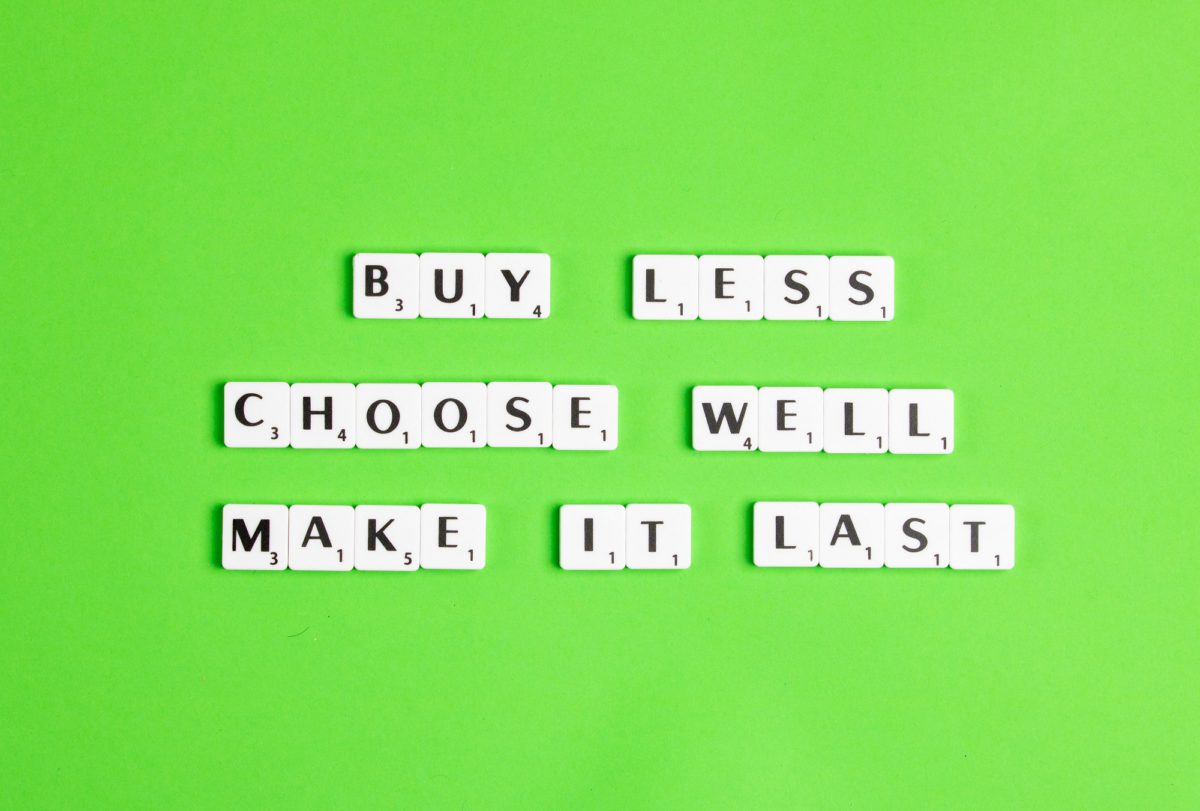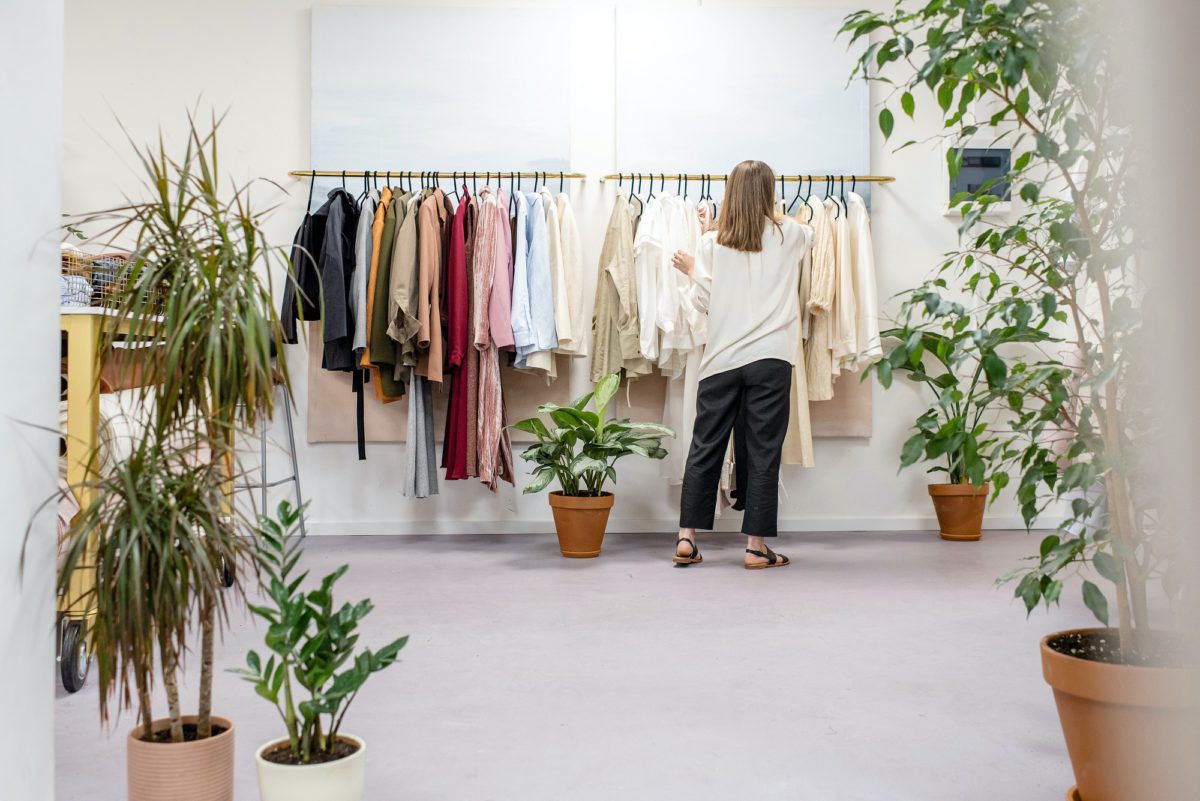Everything you need to know about sustainability and fashion, and how we, as consumers, can protect our planet
Today’s fashion and textile industry is worth over USD 2.5 trillion (EUR 2.25 trillion), with fast fashion leading the way. The average person buys 60% more clothes today than they did two decades ago, but keeps each garment for half as long.[1] The lethal combination of rising consumption and shorter apparel longevity has led to increased global textile waste, which in 2015 was estimated to amount to 92 million tons – and now it is probably more. This means that every year, the average person throws away over 11 pounds (5 kilograms) of shoes and clothing instead of recycling or donating them.[2]
The steep environmental price tag also applies at the beginning of our clothing lifecycle. To make just one cotton shirt, textile manufacturing processes use on average 11 high-grade toxic chemicals and 2,700 liters of water, which is enough for one person to drink for nearly three years.[3] Between raw materials sourcing, dyeing processes and garment manufacturing plants, the industry makes up 4% (and growing) of our global greenhouse gas emissions to date.[4]

The fashion industry also faces ethical dilemmas. In today’s complex supply chains, workers’ rights, safety hazards and low labor wages shed light on the dark corners of factory floors. Controversial raw materials, such as leather and fur, also pose a big question mark on our perception of luxury goods.
However, there has been a shift in the way we dress and shop, which began before the Covid-19 pandemic. Buyers want more than just quality and often search for fashion brands that align with their personal values. Millennials, for example, view shopping as an opportunity to make an impact, buying from brands with ethical business practices and sustainable materials. Zalando, a leader in clothing e-commerce, says that 1 in 3 of its consumers now searches for sustainable fashion items on its website.[5]
On the other side of the spectrum, the fashion and textile industry is revisiting its game plan to meet consumers where they are. New measuring standards, innovative production processes and fresh marketing campaigns flood the scenes to educate buyers on where the brands stand on the green scale. According to Edited, a retail market intelligence platform, the number of searches of the term “sustainable” has quadrupled in the last four years as companies continue to rewrite their mission statements, revisit their supply chains and reallocate resources to go green. [6],[7] Fashion powerhouses, including H&M and Superdry, re-examined their end-of-chain labor policies and switched to organic materials, recycled fibers and renewable packaging.[8]
focuses on the virtuous side of the process, including working conditions, employment wages, gender equality and work ethic. It also considers a brand’s social impact and the creation of equal opportunities.
refers to animal-free fashion, including the elimination of animal testing in the production process and animal-derived materials and components.
defines a movement to increase awareness of a product’s impact on the environment and society. The goal is to transform fashion into an industry that cares about its impact on people and the planet. |

Amidst the ethical and sustainable transformations, the New Standard Institute (NSI), an environmental watchdog, investigates the truth behind today’s labels and campaigns.[9] Founded by a former fashion designer, Maxine Bedat, this initiative aims to monitor and report on activities in the fashion industry. The results show that we have a long way to go, due to three key challenges: buyer awareness, green- and blue-washing schemes, and transparency obstacles.[10]
- Buyer awareness
When shoppers head online or to retail stores, the choice to purchase eco-friendly clothing does not stem from the lack of intent but from the absence of precise and reliable information available. Nearly 1 out of 2 shoppers in the United States do not know how or where to find sustainable apparel, says a recent survey by Genomatica.[11] The same report also indicates that 38% of shoppers blame lack of knowledge for driving their non-eco purchases.[12]
- Green- and blue-washing schemes
The marketplace is inundated with gimmicky marketing ads that tout environmental impact but do very little to save our planet. Instead of rethinking their supply chains and material sourcing, fashion houses invest in “greenwashing” or “bluewashing” campaigns, a tactic suggesting eco-friendly products but fails to deliver on its promises.[13] The International Consumer Protection and Enforcement Network found that over 40% of sustainability claims are misleading consumers today.[14]
- Transparency obstacles
The lack of enforcement or strict oversight gives free rein to fashion firms to disguise how they operate and cover behind-the-scenes activities. Carry Somers, leader of a global activism movement, explains that “people too often confuse sustainability and transparency,” highlighting the concern over the lack of corporate openness and honesty.[15] According to the Fashion Transparency Index, only 7% of fashion brands reveal their manufacturing details, posing real challenges to acquire accurate information.[16]

So, what can be done to make the fashion industry more sustainable? As consumers, we have the power to hold brands accountable by asking four simple questions before making a purchase:
1. How is it made? (the production process, its consequences and carbon footprint)
2. What is it made of? (the sustainability of its components and raw materials)
3. Who made it? (working conditions, ethical business practices, manufacturing transparency)
4. What happens to it after? (recyclability/reusability or will it end up in a landfill)
Answering such questions requires time, effort and research, but it can radically change our consumption patterns and credit firms that truly make an impact.
At industry level, real change begins with big fashion houses that are transforming the way they conduct business. Companies have to re-examine every touchpoint from material sourcing and ethical production to business model transformations. “The fashion industry needs to factor sustainability into its core decision-making process,” states Chloe Foster of the Applied Negative Emissions Centre, a UK organization tackling climate change. “Everything is interconnected, so production decisions need to be made through a holistic approach,” she explains.[17]
Amidst the gray haze, smaller firms emerge to disrupt today’s polluting practices. Emergency Room, ZL Copenhagen and Morgan Bondare represent today’s emblem of excellence in reducing textile overproduction and maximizing the earth’s resources.[18],[19] It’s only a matter of time before consumers make better choices and hold brands accountable to greener and stricter standards. The industry will then need to make a choice: go clean or risk disruption.[20]
Reference
[1] “The hidden reliance of fast fashion on fossil fuels – Changing ….” Available at: http://changingmarkets.org/wp-content/uploads/2021/01/FOSSIL-FASHION_Web-compressed.pdf.
[2] “Textile waste per person in the EU countries in 2016 | Statista.” Available at: https://www.statista.com/statistics/1090566/textile-waste-generated-in-the-european-union-per-person/.
[3] The Boston Consulting Group (2017) Pulse of the Fashion Industry Report. Available at:
http://media-publications.bcg.com/france/Pulse-of-the-Fashion-Industry2019.pdf.
[4] “How the fashion industry can reduce its carbon footprint | McKinsey.” Available at: https://www.mckinsey.com/industries/retail/our-insights/fashion-on-climate.
[5] “Zalando Expects Double-Digit Growth in 2020 – Zalando Corporate.” Available at: https://corporate.zalando.com/en/investor-relations/news-stories/zalando-expects-double-digit-growth-2020.
[6] “Sustainability EDIT 2020 – EDITED.” Available at: https://edited.com/wp-content/uploads/2020/10/The-Sustainability-EDIT-2020-Report-1.pdf.
[7] “Sustainable fashion? There’s no such thing | Financial Times.” Available at: https://www.ft.com/content/d174e7d7-97c4-43fc-8765-95075e5fcce7.
[8] “From the Source: Meet our Organic Farmers – Superdry.” Available at: https://corporate.superdry.com/sustainability/sustainable-stories/from-the-source-meet-our-organic-farmers/.
[9] “New Standard Institute.”- Available at: https://www.newstandardinstitute.org/.
[10] “Can This Group Put an End to Fake News About Sustainable Fashion?” Available at: https://www.vogue.com/article/maxine-bedat-new-standard-institute-sustainable-fashion-resource.
[11] “Survey: consumers want sustainable clothing, need more info ….”Available at: https://www.genomatica.com/survey-consumers-want-sustainable-clothing-need-more-info/.
[12] “Consumers Are Confused About What ‘Sustainability’ Means in ….” Available at: https://www.thefashionlaw.com/consumers-are-confused-about-what-sustainability-means-in-fashion-per-new-survey/.
[13] “What is greenwashing? | Ethical Consumer.” Available at: https://www.ethicalconsumer.org/transport-travel/what-greenwashing.
[14] “The big global greenwashing crackdown | Vogue Business.” Available at: https://www.voguebusiness.com/sustainability/the-big-global-greenwashing-crackdown.
[15] “Are Brands Really Being Sustainable, or Greenwashing? Here’s ….” Available at: https://en.vogue.me/fashion/greenwashing-in-fashion/.
[16] “In 2021, Fast Fashion is Still a Big Threat to Our … – Vogue Arabia.” Available at: https://en.vogue.me/fashion/fast-fashion-2021-statistics/.
[17] “Are Brands Really Being Sustainable, or Greenwashing? Here’s ….” Available at: https://en.vogue.me/fashion/greenwashing-in-fashion/.
[18] “ZLCOPENHAGEN melange of cultures, stylish but eco-friendly ….” Available at: https://www.econyl.com/blog/case-studies-fashion/zlcopenhagen-melange-of-cultures-stylish-but-eco-friendly/.
[19] “Sustainable multi-functional, multi-purpose bag with a focus … – Econyl.” Available at: https://www.econyl.com/blog/case-studies-fashion/sustainable-multi-functional-multi-purpose-bag-with-a-focus-on-circular-materials/.
[20] “The future of sustainable fashion | McKinsey.” Available at: https://www.mckinsey.com/industries/retail/our-insights/the-future-of-sustainable-fashion.
Author: Naomy Gmyrek
